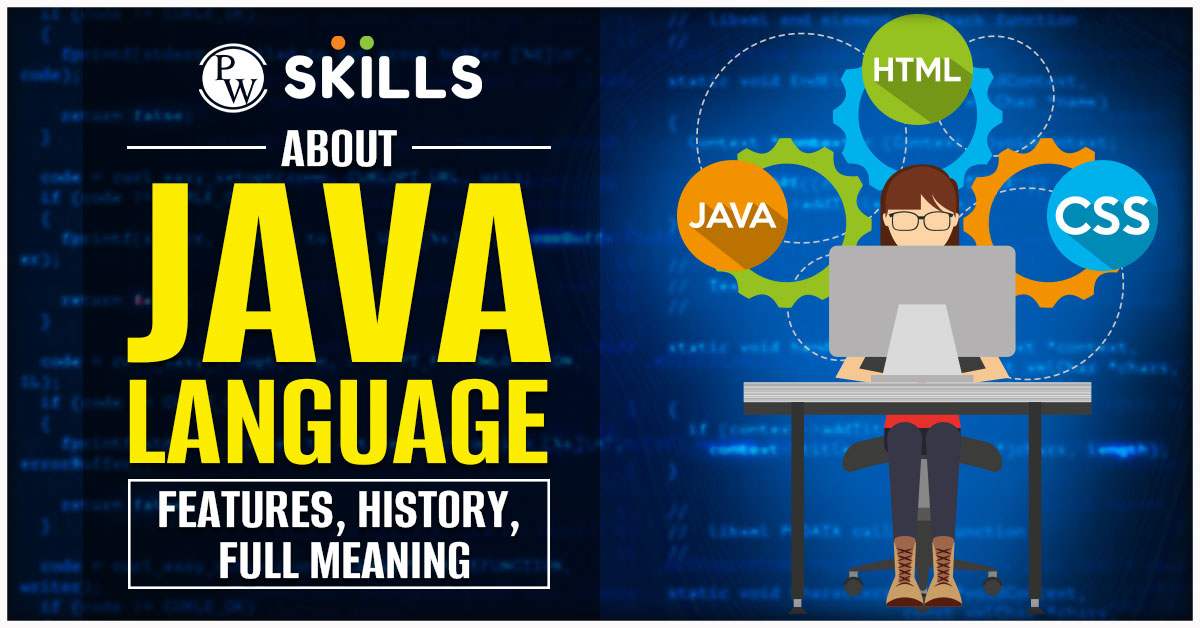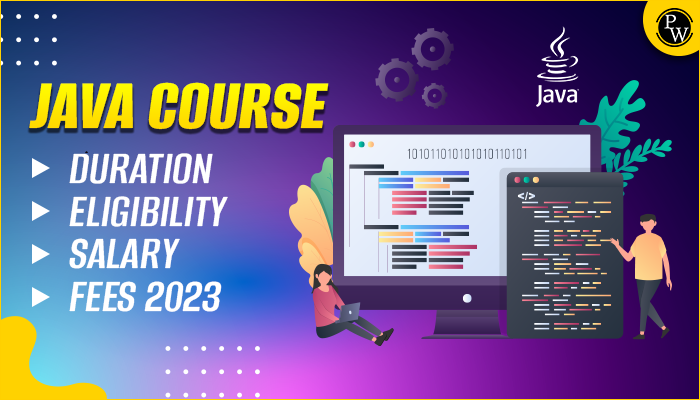Unveiling the Java Language: Check Features, History, and Full Meaning
About Java Language: Java is a versatile, high-performance programming language renowned for its platform independence, making it a cornerstone in web development, mobile applications, and enterprise systems. Introduced by Sun Microsystems in 1995, Java’s strength lies in its “write once, run anywhere” mantra, enabling code portability across diverse environments.
Its object-oriented nature, strong memory management, and robust security features contribute to its widespread adoption. Java powers a multitude of applications, from Android apps to large-scale enterprise solutions, making it a fundamental language in the software development landscape.

Its simplicity, scalability, and community support continue to solidify Java’s significance in the ever-evolving tech industry. In this article, we’ll talk about Java Language, its definition, programming language, features, history, and more!
If you’re looking to kickstart a career in Web Development, PhysicsWallah’s Full Stack Development course could really help you in your career. With our course, you’ll be job-ready and will be equipped with all the skills and knowledge needed to succeed in your career! So, don’t wait, enrol now! Use Coupon code “READER” at checkout to get exclusive discounts!
About Java Language Definition
Java is a powerful, object-oriented, and versatile programming language that was introduced by Sun Microsystems in 1995. It was designed with the principle of “write once, run anywhere,” allowing developers to create applications that can run on any device or platform with a Java Virtual Machine (JVM).
This platform independence is achieved by compiling Java code into an intermediate form called bytecode, which can be executed on any system that has a compatible JVM.
Java’s syntax is similar to C++, making it accessible to a broad range of developers. It is renowned for its simplicity, readability, and ease of maintenance. The language supports multithreading, enabling concurrent execution of tasks, and its automatic memory management through garbage collection enhances program efficiency.
Java has found widespread use in various domains, including web development, mobile app development (particularly for Android), enterprise systems, and cloud computing. It boasts a rich standard library and a vast ecosystem of third-party libraries and frameworks.
The Java Community Process (JCP) governs the evolution of Java, ensuring continuous updates and improvements. Overall, Java’s adaptability, portability, and extensive community support have solidified its position as a cornerstone in the world of software development.
Also Read: 2D Array in Java – Example, Questions
About Java Programming Language
Java is a robust, object-oriented programming language renowned for its versatility and cross-platform compatibility. Introduced by Sun Microsystems in 1995, it emphasises simplicity, readability, and write-once-run-anywhere capabilities. Java applications are compiled into bytecode, enabling them to run on any device with a Java Virtual Machine (JVM). This platform independence has made Java a primary choice for diverse applications, from web development to mobile and enterprise solutions.
Java’s syntax, influenced by C++, is accessible to a broad audience, and its automatic memory management through garbage collection simplifies memory handling for developers. The language supports multithreading, facilitating concurrent execution of tasks. The extensive Java Standard Library and a vibrant ecosystem of frameworks contribute to its popularity.
What is Java Programming Used for?
Java is a versatile programming language with a wide range of applications across various domains. Here are key points highlighting the uses of Java:
- Web Development: Java is widely employed for building robust and scalable web applications, utilising frameworks like Spring and JavaServer Faces (JSF).
- Mobile App Development: Java is the official language for developing Android applications, making it a crucial tool for mobile app developers.
- Enterprise Applications: Java is extensively used in building large-scale, enterprise-level applications, where its reliability, scalability, and maintainability play a crucial role.
- Desktop Applications: Java Swing and JavaFX frameworks allow developers to create cross-platform desktop applications with rich graphical user interfaces.
- Cloud Computing: Java’s portability and compatibility make it suitable for developing cloud-based applications and services.
- Big Data Technologies: Java is widely used in the big data ecosystem, with frameworks like Apache Hadoop and Apache Spark being implemented in Java.
- Scientific and Research Applications: Java is employed in scientific research and computational applications due to its performance and extensive libraries.
- Embedded Systems: Java’s platform independence makes it suitable for embedded systems development, where space constraints may require a compact yet powerful language.
- Internet of Things (IoT): Java is used in IoT development, connecting devices and facilitating communication between them.
- Game Development: Java, with libraries like LibGDX, is used in the development of 2D and 3D games, providing a versatile platform for game developers.
In essence, Java’s adaptability, portability, and extensive ecosystem make it a preferred choice for a broad spectrum of applications, ranging from small-scale projects to large, mission-critical systems.
Features of Java
Java, a robust and versatile programming language, incorporates several key features that contribute to its widespread adoption and success:
- Platform Independence: Java’s “Write Once, Run Anywhere” principle is achieved through the use of bytecode, allowing Java programs to run on any device with a Java Virtual Machine (JVM), enhancing portability.
- Object-Oriented: Java follows the object-oriented programming paradigm, facilitating modular and scalable code development, promoting code reuse and maintenance.
- Simple and Readable: Java’s syntax, inspired by C++, emphasises simplicity and readability, making it accessible to a wide range of developers and promoting code clarity.
- Automatic Memory Management: Java incorporates garbage collection, relieving developers from manual memory management tasks, enhancing code efficiency and reducing the risk of memory-related errors.
- Multithreading Support: Java enables the concurrent execution of multiple threads, facilitating the development of responsive and efficient applications, particularly useful in handling parallel tasks.
- Rich Standard Library: Java provides a comprehensive set of libraries and APIs, covering a wide range of functionalities, reducing the need for developers to write extensive code from scratch.
- Security: Java incorporates built-in security features, including the sandbox environment for applets and a robust set of APIs for encryption, authentication, and access control, enhancing the overall security of Java applications.
- Distributed Computing: Java supports the development of distributed applications through technologies like RMI (Remote Method Invocation) and JMS (Java Message Service), facilitating seamless communication between components.
- Dynamic and Extensible: Java allows for dynamic loading of classes, facilitating the addition of new functionality during runtime. It also supports dynamic linking and reflection, enhancing flexibility.
- Community Support: Java has a vibrant and active community that contributes to its continuous development. The Java Community Process (JCP) ensures community involvement in shaping the language’s evolution.
In summary, Java’s features such as platform independence, object-oriented design, simplicity, automatic memory management, and strong community support contribute to its enduring popularity and versatility in a diverse range of application domains.
Also Read: Spring Boot Tutorial
History of Java
- Origins (Early 1990s):
Developed by James Gosling, Mike Sheridan, and Patrick Naughton at Sun Microsystems. Originally named Oak, the language aimed at creating software for consumer electronic devices.
- Renaming to Java (1995):
Renamed Java due to trademark issues and a shift in focus towards the emerging market of Internet applications.
Officially released in 1995 with the slogan “Write Once, Run Anywhere” to emphasise its cross-platform capabilities.
- Java 1.0 (1996):
The first public version of Java was released in January 1996. Included core features such as applets for web browsers and the Java Foundation Classes (JFC).
- Java 2 (J2SE 1.2, 1998):
Introduced significant enhancements, including the Swing GUI toolkit, Collections Framework, and the “strictfp” keyword. Marked the beginning of the Java 2 Platform, Standard Edition (J2SE).
- Enterprise Java (J2EE, 1999):
Introduced the Java 2 Platform, Enterprise Edition (J2EE) to address enterprise-level computing, including servlets, JSP, and EJB components.
- Java 2 Micro Edition (J2ME, 1999):
Focused on providing a platform for mobile and embedded systems, extending Java’s reach to a broader range of devices.
- Open Sourcing (2006):
Sun Microsystems released the source code of Java under the GNU General Public License (GPL), making it open source and leading to the creation of the OpenJDK (Java Development Kit).
- Acquisition by Oracle (2010):
Oracle Corporation acquired Sun Microsystems, becoming the steward of Java and continuing its development.
- Java 8 (2014):
Introduced lambdas, the Stream API, and the java.time package, bringing significant improvements to functional programming and date/time handling.
- Java 11 and Beyond (2018 Onwards):
Oracle transitioned to a time-driven release model, providing more frequent and predictable updates. Java continues to evolve with features like modularization (Project Jigsaw), record types, and enhancements to garbage collection.
The history of Java reflects its evolution from a language for consumer electronics to a ubiquitous, versatile platform, continually adapting to technological changes and maintaining its significance in the software development landscape.
What is the Full Meaning of Java?
Java is not an acronym and therefore does not have a full form. It was originally named “Oak” but later renamed “Java” by its developers James Gosling, Mike Sheridan, and Patrick Naughton at Sun Microsystems. The name Java was chosen for its simplicity and association with the coffee culture at Sun.
The developers sought a distinctive, trademarkable name for their programming language, and Java has since become synonymous with a versatile, platform-independent language widely used in web, mobile, and enterprise applications.
Also Read: Best Online Platform To Learn Java Programming Course
Java Tutorial
- Environment Setup:
- Install the Java Development Kit (JDK) on your system.
- Set up the Java environment variables for seamless execution.
- Understanding Java Basics:
- Learn about Java’s syntax, data types, and variables.
- Grasp the concept of classes and objects in object-oriented programming.
- Control Flow Statements:
- Explore decision-making with if-else statements.
- Understand loops, including for, while, and do-while.
- Methods and Functions:
- Comprehend the creation and usage of methods in Java.
- Learn about function parameters and return types.
- Object-Oriented Concepts:
- Dive into the principles of encapsulation, inheritance, and polymorphism.
- Understand abstraction and interfaces in Java.
- Exception Handling:
- Familiarise yourself with handling errors and exceptions in Java.
- File Handling:
- Learn how to read from and write to files using Java.
- Introduction to Java APIs:
- Explore commonly used Java APIs and libraries.
- Basic GUI Programming (Optional):
- Get an overview of Java’s Graphical User Interface (GUI) components.
- Advanced Topics (Optional):
- Explore advanced topics such as multithreading, networking, and database connectivity.
Remember to practise coding regularly, as hands-on experience is essential for mastering Java programming. Online tutorials, documentation, and community forums can provide additional support and insights.
Who Developed Java?
Java was developed by James Gosling, Mike Sheridan, and Patrick Naughton at Sun Microsystems in the early 1990s. They initially created the programming language, originally named Oak, for consumer electronic devices. The team aimed to develop a language that could be used to program intelligent consumer electronic devices like set-top boxes.
However, as the internet emerged and new opportunities arose, the focus of Java shifted towards web-based applications. Java was officially released to the public in 1995, and it quickly gained popularity due to its platform independence and “Write Once, Run Anywhere” philosophy. Sun Microsystems continued to oversee Java’s development until it was acquired by Oracle Corporation in 2010.
What is Java Language used for?
Java is a versatile programming language widely used for various applications. Its platform independence allows Java applications to run on any device with a Java Virtual Machine (JVM), making it integral in diverse domains.
- Web Development: Java is employed to build scalable and robust web applications using frameworks like Spring and JavaServer Faces (JSF).
- Mobile App Development: It is the official language for Android app development, powering a significant portion of the mobile ecosystem.
- Enterprise Systems: Java is a cornerstone in building large-scale enterprise applications due to its reliability, scalability, and maintainability.
- Desktop Applications: Java, with frameworks like Swing and JavaFX, facilitates the development of cross-platform desktop applications.
- Cloud Computing: Java is used for developing cloud-based applications and services, leveraging its portability and compatibility.
- Big Data: Java is utilised in big data processing frameworks such as Apache Hadoop and Apache Spark.
- Scientific Computing: Java is applied in scientific research and computational applications for its performance and extensive libraries.
Its adaptability, rich ecosystem, and strong community support contribute to Java’s enduring popularity in the software development landscape.
Also Read: Java OOPs Concept
What is Java Full Introduction?
Java is a powerful, object-oriented, and platform-independent programming language developed by James Gosling, Mike Sheridan, and Patrick Naughton at Sun Microsystems in the early 1990s. Originally named Oak, it was designed for consumer electronic devices. Java’s defining feature is its “Write Once, Run Anywhere” philosophy, achieved through the compilation of code into bytecode, allowing it to run on any device with a Java Virtual Machine (JVM).
Java supports features like automatic memory management (garbage collection), multithreading, and a robust standard library. It has widespread use in web development, mobile app development (particularly Android), enterprise systems, cloud computing, and more. Java’s syntax is derived from C++, emphasising simplicity and readability.
Oracle Corporation currently oversees Java’s development after acquiring Sun Microsystems in 2010. With a vibrant community and continuous updates, Java remains a pivotal language in the ever-evolving field of software development.
What Is Java Full Form?
Java does not have a full form. It is not an acronym; instead, the name “Java” was chosen by its developers James Gosling, Mike Sheridan, and Patrick Naughton at Sun Microsystems. The name was inspired by their interest in coffee, particularly the coffee beans from Java, Indonesia.
Java was originally named Oak, but due to trademark issues and a shift in focus towards the emerging market of Internet applications, it was later renamed Java before its official release in 1995. The choice of the name reflects the developers’ desire for a distinctive and trademarkable title for their programming language.
Why Is Java So Used?
Java is extensively used for several compelling reasons that contribute to its enduring popularity in the world of software development.
Firstly, Java’s platform independence is a standout feature, allowing developers to write code once and run it on any device with a Java Virtual Machine (JVM). This portability is crucial for applications across diverse environments.
Secondly, Java’s versatility is evident in its broad range of applications, from web development and mobile apps (especially Android) to enterprise-level systems, cloud computing, and big data processing. Its object-oriented nature facilitates modular and scalable code development, promoting code reuse and maintainability.
Additionally, Java’s robust standard library and extensive ecosystem of third-party libraries and frameworks provide developers with powerful tools, reducing the need for writing extensive code from scratch.
Furthermore, Java’s large and active community, along with continuous updates and improvements, ensures ongoing support and relevance. The language’s focus on security, automatic memory management, and multithreading support adds to its appeal for building reliable and efficient applications. Overall, Java’s combination of portability, versatility, robust features, and community support makes it a preferred choice for a wide range of development tasks.
About Java Language FAQs
What is Java's key feature?
Java's key feature is its platform independence, enabling developers to write code that can run on any device with a Java Virtual Machine (JVM).
Why is Java popular for web development?
Java's robustness, scalability, and versatility make it a popular choice for building web applications, and frameworks like Spring provide efficient tools for developers.
Is Java only used for web development?
No, Java is versatile and employed in various domains, including mobile app development (Android), enterprise solutions, cloud computing, big data processing, and scientific computing.
How is Java's memory management handled?
Java features automatic memory management through garbage collection, relieving developers from manual memory handling tasks.
Why is Java considered secure?
Java incorporates built-in security features, such as a sandbox environment for applets and APIs for encryption, authentication, and access control, ensuring a secure development environment.



